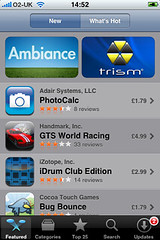Apple shaking up mobile
We're living in an interesting time for anyone selling mobile applications and services. This particular slice of the telecomms value chain is getting a little shaken up, in ways which I believe will ultimately be good for both consumers and the industry.
Today in Europe we have 2 significant platforms on which to develop apps and services and 2 worthwhile means of distribution. The platforms are mobile web and J2ME, and the means of distribution are via portal or by text-message response (text in a keyword to a shortcode, get a link to the application back).
Yes, there are others; Flash, Python, BREW, widget runtimes and native applications all have their place - but none have the audience that J2ME and mobile web deliver. And distribution is possible via Bluetooth and sideloading of applications from PCs, but at Future Platforms we're not seeing this happen in great numbers (with the exception of GetJar, who snuck under my own personal radar and seem to be doing very well, judging from their figures).
I have a suspicion that this is about to change - and it pains me to join the chorus of folks bleating that the iPhone seems to be leading the way. When I first got hold of a (jailbroken) device last year, I was impressed by the third-party installer for applications, which at the time offered the best experience I'd seen for distributing mobile content. Apple have improved on it significantly with their own version: the iTunes App Store.
 At a time when much of the mobile industry in Europe seems content to whine endlessly about the twin bugbears of device fragmentation and operator revenue shares, it's refreshing to see a new entrant arrive, do things differently, and publish numbers demonstrating success. We don't tend to see figures for application downloads from operator portals or third parties here in the UK, I assume probably because the numbers aren't good enough to impress. In contrast, Apple have announced 60 million downloads by August 2008. A few smaller developers are also revealing their figures.
At a time when much of the mobile industry in Europe seems content to whine endlessly about the twin bugbears of device fragmentation and operator revenue shares, it's refreshing to see a new entrant arrive, do things differently, and publish numbers demonstrating success. We don't tend to see figures for application downloads from operator portals or third parties here in the UK, I assume probably because the numbers aren't good enough to impress. In contrast, Apple have announced 60 million downloads by August 2008. A few smaller developers are also revealing their figures.
Now there's a slight difficulty comparing numbers here because the App Store aggregates upwards of a million potential customers from across all the operators selling iPhones (one per territory right now, I believe); so we can't just compare these figures to, say, those for Orange UK (were Orange UK to release figures). But they still indicate there's a significant marketplace here; remember that with Apple taking 30% of revenue rather than the traditional 50% common in Europe, and providing all distribution (instead of app providers having to do their own or go via an aggregator) the margins are higher. And I'm honour-bound to point out that this is for a single device - so no porting costs (though higher costs for initial development, with Cocoa/C++ apps being more technically complex than J2ME - another post on that coming soon).
I'm frankly astonished that Apple have managed to enter an industry, partner with the incumbents and smoothly route around them in this way - though I'm not privy to commercial agreements between operators and Apple, which might provide a revenue stream back to them I suppose. It looks like classic "divide and conquer" to me, and leaves Apple owning the customer's mobile data experience (if not traffic), whilst their operator partners keep control over voice calls and text messaging.
If you work in mobile right now, you'll be as sick as me of everyone bleating about the importance of mobile user experience - as though it suddenly became an issue the day that Apple launched their Big Shiny. But obviously it plays a role. And Google seem to be following suit withe their Android "marketplace" (so much less materialistic than calling it a "store", doncha know) - though with the existing mobile industry customising Android to its hearts content, how watered down this is by the time it reaches consumers is a completely different matter.
My best-case outcome for Android: the mobile industry wakes up, sees Apple, craps itself and starts unashamedly lifting the best bits of the iPhone model in customising Android devices. It does a reasonable job, producing handsets 75% as good as iPhone and selling them well.
My worst-case outcome for Android: operators and handset vendors buy it, lobotomise it to fit into the way they've always done things, and it ends up in the same cupboard as SavaJe.
But what a fun time to be working in mobile applications (which, plug plug, is where my company sits): good commercial results, an industry being shaken up, and the largest handset vendor in the world (Nokia) moving in a similar direction with Ovi. After seeing a few presentations over the last year where accepted wisdom was that there's no future in applications (and knowing full well this isn't the case - I have some fantastic figures to post here when I get permission), it's good to see a sacred cow or two get slaughtered in Cupertino.